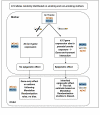Can we apply the Mendelian randomization methodology without considering epigenetic effects?
- PMID: 19432981
- PMCID: PMC2698894
- DOI: 10.1186/1742-7622-6-3
Can we apply the Mendelian randomization methodology without considering epigenetic effects?
Abstract
Introduction: Instrumental variable (IV) methods have been used in econometrics for several decades now, but have only recently been introduced into the epidemiologic research frameworks. Similarly, Mendelian randomization studies, which use the IV methodology for analysis and inference in epidemiology, were introduced into the epidemiologist's toolbox only in the last decade.
Analysis: Mendelian randomization studies using instrumental variables (IVs) have the potential to avoid some of the limitations of observational epidemiology (confounding, reverse causality, regression dilution bias) for making causal inferences. Certain limitations of randomized controlled trials, such as problems with generalizability, feasibility and ethics for some exposures, and high costs, also make the use of Mendelian randomization in observational studies attractive. Unlike conventional randomized controlled trials (RCTs), Mendelian randomization studies can be conducted in a representative sample without imposing any exclusion criteria or requiring volunteers to be amenable to random treatment allocation.Within the last decade, epigenetics has gained recognition as an independent field of study, and appears to be the new direction for future research into the genetics of complex diseases. Although previous articles have addressed some of the limitations of Mendelian randomization (such as the lack of suitable genetic variants, unreliable associations, population stratification, linkage disequilibrium (LD), pleiotropy, developmental canalization, the need for large sample sizes and some potential problems with binary outcomes), none has directly characterized the impact of epigenetics on Mendelian randomization. The possibility of epigenetic effects (non-Mendelian, heritable changes in gene expression not accompanied by alterations in DNA sequence) could alter the core instrumental variable assumptions of Mendelian randomization.This paper applies conceptual considerations, algebraic derivations and data simulations to question the appropriateness of Mendelian randomization methods when epigenetic modifications are present.
Conclusion: Given an inheritance of gene expression from parents, Mendelian randomization studies not only need to assume a random distribution of alleles in the offspring, but also a random distribution of epigenetic changes (e.g. gene expression) at conception, in order for the core assumptions of the Mendelian randomization methodology to remain valid. As an increasing number of epidemiologists employ Mendelian randomization methods in their research, caution is therefore needed in drawing conclusions from these studies if these assumptions are not met.
Figures





Similar articles
-
[Mendelian randomization approach, used for causal inferences].Zhonghua Liu Xing Bing Xue Za Zhi. 2017 Apr 10;38(4):547-552. doi: 10.3760/cma.j.issn.0254-6450.2017.04.027. Zhonghua Liu Xing Bing Xue Za Zhi. 2017. PMID: 28468080 Clinical Trial. Chinese.
-
Limits to causal inference based on Mendelian randomization: a comparison with randomized controlled trials.Am J Epidemiol. 2006 Mar 1;163(5):397-403. doi: 10.1093/aje/kwj062. Epub 2006 Jan 12. Am J Epidemiol. 2006. PMID: 16410347 Review.
-
[Challenges and factors that influencing causal inference and interpretation, based on Mendelian randomization studies].Zhonghua Liu Xing Bing Xue Za Zhi. 2020 Aug 10;41(8):1231-1236. doi: 10.3760/cma.j.cn112338-20200521-00749. Zhonghua Liu Xing Bing Xue Za Zhi. 2020. PMID: 32867428 Review. Chinese.
-
Mendelian randomization as an instrumental variable approach to causal inference.Stat Methods Med Res. 2007 Aug;16(4):309-30. doi: 10.1177/0962280206077743. Stat Methods Med Res. 2007. PMID: 17715159 Review.
-
Mendelian randomization: can genetic epidemiology help redress the failures of observational epidemiology?Hum Genet. 2008 Feb;123(1):15-33. doi: 10.1007/s00439-007-0448-6. Epub 2007 Nov 23. Hum Genet. 2008. PMID: 18038153 Review.
Cited by
-
Smoking, use of smokeless tobacco, HLA genotypes and incidence of latent autoimmune diabetes in adults.Diabetologia. 2023 Jan;66(1):70-81. doi: 10.1007/s00125-022-05763-w. Epub 2022 Jul 28. Diabetologia. 2023. PMID: 35900371 Free PMC article.
-
A Mendelian Randomization Study of Plasma Homocysteine and Multiple Myeloma.Sci Rep. 2016 Apr 29;6:25204. doi: 10.1038/srep25204. Sci Rep. 2016. PMID: 27126524 Free PMC article.
-
The causal effect of red blood cell folate on genome-wide methylation in cord blood: a Mendelian randomization approach.BMC Bioinformatics. 2013 Dec 4;14:353. doi: 10.1186/1471-2105-14-353. BMC Bioinformatics. 2013. PMID: 24305512 Free PMC article.
-
Genetically determined hypoalbuminemia as a risk factor for hypertension: instrumental variable analysis.Sci Rep. 2021 May 28;11(1):11290. doi: 10.1038/s41598-021-89775-3. Sci Rep. 2021. PMID: 34050200 Free PMC article.
-
Causal effects of retinol and vitamin D on tongue cancer risk: a mendelian randomization study.BMC Oral Health. 2025 Jan 11;25(1):52. doi: 10.1186/s12903-024-05407-y. BMC Oral Health. 2025. PMID: 39799281 Free PMC article.
References
Grants and funding
LinkOut - more resources
Full Text Sources
Molecular Biology Databases
Research Materials
Miscellaneous

